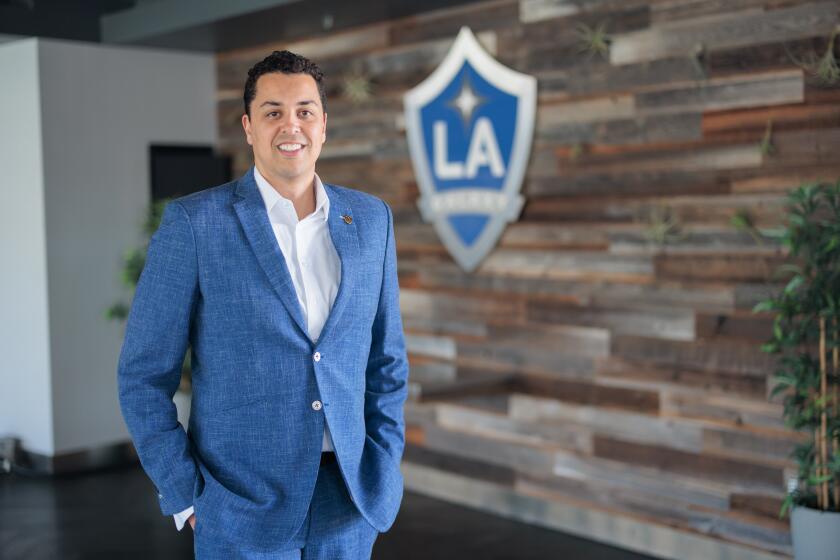FIFTH ELEMENTS
The two-dozen most encouraging words ever uttered about soccer in the United States were voiced by one of the wealthiest men on the planet.
âThis isnât about a monetary investment,â Phil Anschutz said. âThis is about a hell of a sport that deserves to be big-time in this country.â
If anyone can spin straw into gold, itâs Anschutz. His dream and his vision are one reason Major League Soccer will kick off its fifth season Saturday in a more optimistic mood than ever before.
Because Anschutz, worth an unimaginable $16.5 billion, is backing his words with deeds.
As recently as Wednesday, the Galaxy--one of three Anschutz-owned MLS teams--announced its intention to build a soccer-specific stadium in the Los Angeles area.
According to Tim Leiweke, the clubâs president, the Galaxy also is interested in constructing a national training center here that would be the home to all U.S. national teams and make Los Angeles, he said, âthe heart and soul of soccer in this country.â
On the same day, the Chicago Fire, also an Anschutz team, said it was exploring the feasibility of building a new stadium in Chicago or, in the words of General Manager Peter Wilt, âthe total reconstruction of Soldier Fieldâ as an MLS stadium.
Denver too probably will be the beneficiary of a new home for Anschutzâs Colorado Rapids, while the New York/New Jersey MetroStars are contemplating building their own stadium in Newark, N.J.
The commitment to such ventures--Lamar Huntâs Columbus Crew Stadium has been up and running for a season--underlines the optimism the leagueâs investor-operators feel about soccerâs future in the U.S.
There is also a renewed energy brought about by the changes introduced by Don Garber, the former NFL executive who replaced Doug Logan as commissioner last fall.
* The shootout is gone, replaced by 10 minutes of sudden-death overtime. If that doesnât produce a result, ties will stand.
* The 12 MLS teams have been realigned into three four-team conferences, providing new rivalries.
* The three conference champions will advance to the playoffs, along with five wild-card teams based on points and regardless of division.
* MLS has fallen in line with international rules to woo back fans who were tired of gimmicks. There will be three points for a win and one for a tie; the stadium clock will count up, not down, and the referee will keep official time on the field.
* Redesigned uniforms will give teams a fresh look.
âOur core audience spoke, and we listened,â Garber said.
Most important, perhaps, MLS has lured a handful of world-renowned players into its ranks for the 2000 season.
The MetroStars led the way by bringing in Germanyâs World Cup-winning captain, Lothar Matthaeus, and Colombiaâs veteran striker, Adolfo âEl Trenâ Valencia.
The San Jose Earthquakes added Iranian star Khodadad Azizi, and the Fire signed Bulgariaâs World Cup playmaker, Hristo Stoichkov. A top-flight Mexican player is believed to be in the Galaxyâs future.
Then there are the lesser-known but no less promising players discovered by teams, players such as the Fireâs Junior Agogo from Ghana via England, the Kansas City Wizardsâ Miklos Molnar from Denmark via Spain, the Tampa Bay Mutinyâs Mamadou Diallo from Senegal and the New England Revolutionâs William Sunsing from Costa Rica.
âOverall, the influx of good foreigners this year is the best weâve had,â Columbus Coach Tom Fitzgerald said. âThe quality of play on the field will show that.â
The 2000 MLS draft provided another dozen or so players capable of making an impression right away, including such American youngsters as D.C. Unitedâs Bobby Convey, 16, and the Fireâs DaMarcus Beasley, 17, as the league fought, sometimes unsuccessfully, to keep future prospects from going overseas to play.
Add these new players to such established MLS names as Marco Etcheverry, Carlos Valderrama, Cobi Jones, Mauricio Cienfuegos, Jaime Moreno, Brian McBride and Leonel Alvarez, as well as to rising stars such as Ariel Graziani and Ronald Cerritos, and the fans could be back in large numbers.
Attendance has flat-lined over the last three seasons, the average hovering just above 14,000 after MLS drew more than 17,000 in 1996, its inaugural season.
Large and loud crowds in 2000 will be important for a couple of reasons. One, to show team owners that their faith in the future of the sport here is justified. Two, because of the leagueâs new television package.
Games will be shown on ABC, ESPN and ESPN2, as well as the Spanish-language network Telemundo, on Saturdays, starting April 29.
In addition, there will be a one-hour highlights and features show on ESPN2 on Monday nights between June 19 and Sept. 11.
Overall, despite hefty problems, the future for MLS looks better than it has since the leagueâs euphoric first season. But the road ahead is still a long one.
âI donât think there is going to be a eureka moment where suddenly we are going to cross a threshold and be the NBA,â said Kevin Payne, president and general manager of three-time champion D.C. United.
âI think the way you get there is you just do more and more things better on a regular basis and, over time, these things compound each other.â
It all begins Saturday.






